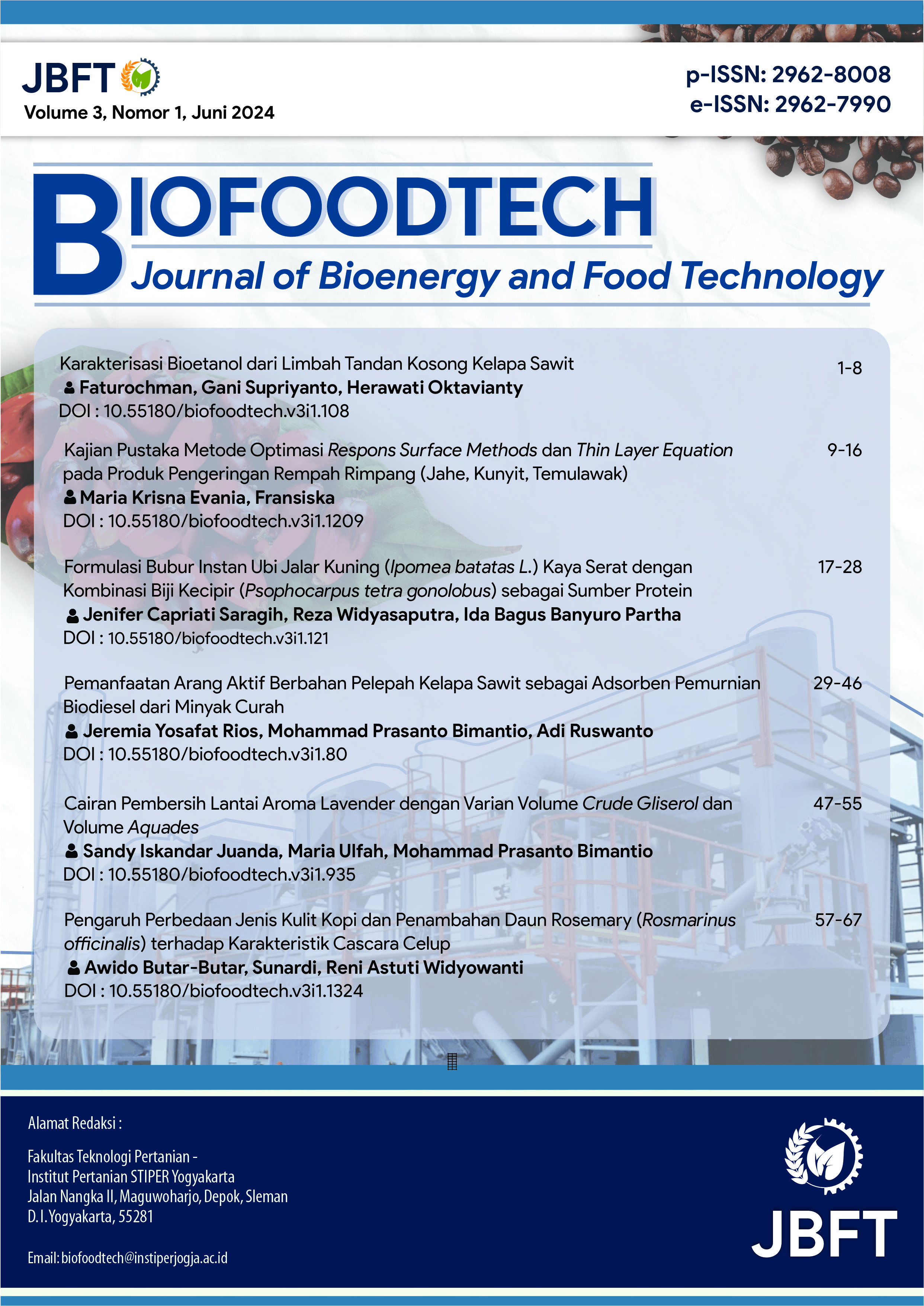Pengaruh Perbedaan Jenis Kulit Kopi dan Penambahan Daun Rosemary (Rosmarinus officinalis) terhadap Karakteristik Cascara Celup
DOI:
https://doi.org/10.55180/biofoodtech.v3i1.1324Kata Kunci:
arabica coffee skin, cascara dip, robusta coffee skin, rosemaryAbstrak
The objectives of this study are: (1) to determine the effect of coffee skin type with the addition of rosemary leaf powder on the characteristics of cascara dip; (2) to know the formulation of the type of coffee skin with the addition of rosemary leaf powder that produces the most preferred cascara dip for the panelists. The latest in this study is an innovation to eliminate the taste of cascara with rosemary leaf powder, as well as practical and contemporary presentation in the form of dip cascara. The research will use 2 factors. The first factor is type coffee skin (A) with 3 levels, namely A1= arabica coffee skin, A2= robusta coffee skin, and A3 = arabica and robusta coffee skin blend with a 1:1 ratio. The second factor is the addition of rosemary leaf powder by weight of cascara with 3 levels, namely B1= 2%, B2= 4%, and B3= 6%. The results of the study showed that: (1) The type of coffee skin with the addition of rosemary leaves had an effect on the tannin content, taste, and color of the cascara dip. But it has no effect on antioxidant levels, caffeine levels, total acidity, total color difference, and aroma. (2) Cascara dip made from arabica coffee bark with the addition of 2% rosemary leaves (A1B1) is a cascara that consumers prefer (somewhat like) has an antioxidant level of A1B1 37.397%, caffeine 0.97%, tannins 0.0080, total acid 0.109, total color difference 29.173, moisture content 5.57% and ash content 1.815%.
Referensi
Abduh, M. Y., Nofitasari, D., Rahmawati, A., Eryanti, A. Y., & Rosmiati, M. (2023). Effects of brewing conditions on total phenolic content, antioxidant activity and sensory properties of cascara. Food Chemistry Advances, 2. https://doi.org/10.1016/j.focha.2023.100183
Aziz, E., Batool, R., Akhtar, W., Shahzad, T., Malik, A., Shah, M. A., Iqbal, S., Rauf, A., Zengin, G., Bouyahya, A., Rebezov, M., Dutta, N., Khan, M. U., Khayrullin, M., Babaeva, M., Goncharov, A., Shariati, M. A., & Thiruvengadam, M. (2022). Rosemary species: A review of phytochemicals, bioactivities and industrial applications. South African Journal of Botany, 151. https://doi.org/10.1016/j.sajb.2021.09.026
Azzahrah, A. A., Budiraharjo, K., & Handayani, M. (2023). Analisis Faktor Produksi Kopi Robusta. Jurnal Sosial Ekonomi Pertanian, 19(3). https://doi.org/10.20956/jsep.v19i3.29904
de Macedo, L. M., Dos Santos, É. M., Militão, L., Tundisi, L. L., Ataide, J. A., Souto, E. B., & Mazzola, P. G. (2020). Rosemary (Rosmarinus officinalis L., syn salvia rosmarinus spenn.) and its topical applications: A review. Dalam Plants (Vol. 9, Nomor 5). https://doi.org/10.3390/plants9050651
Esati, N. K., Jawa La, E. O., & Lestari, G. A. D. (2022). Uji Aktivitas Antioksidan Ekstrak Etanol Daun Rosemary (Rosemarinus officinalis L.) dengan Metode DPPH dan FRAP serta Pengaplikasiannya sebagai Zat Aktif dalam Losion. Jurnal Sains dan Kesehatan, 4(4). https://doi.org/10.25026/jsk.v4i4.1129
Ismail, A. Y., Kosasih, D., & Nurlaila, A. (2022). Peningkatan Nilai Tambah melalui Pembuatan Pupuk Organik Padat dan Cair dari Limbah Kulit Buah Aren (Arenga Pinata). Empowerment : Jurnal Pengabdian Masyarakat, 5(01). https://doi.org/10.25134/empowerment.v5i01.5679
Khasanah, L. U., Fathinatullabibah, & Kawiji. (2014). Stabilitas Antosianin Ekstrak Daun Jati ( Tectona grandis ) terhadap Perlakuan pH dan Suhu. Jurnal Aplikasi Teknologi Pangan 3 (2), 3(2), 60–63.
Kusbandari, A., Prasetyo, D. Y., & Susanti, H. (2018). PENETAPAN KADAR FENOLIK TOTAL DAN AKTIVITAS ANTIOKSIDAN EKSTRAK ETANOL DAUN KOPI KAWA DENGAN METODE DPPH. Media Farmasi: Jurnal Ilmu Farmasi, 15(2). https://doi.org/10.12928/mf.v15i2.12658
Nabila, A., Puspitasari, C. E., & Erwinayanti, G. A. P. S. (2020). Uji Aktivitas Antioksidan Ekstrak Etanol Daun Rosemary (Rosemarinus officinalisL.) dengan Metode DPPH dan FRAP serta Pengaplikasiannya sebagai Zat Aktif dalam Losion. Jurnal Sains dan Kesehatan, 3(1).
Rohaya, S., Multahadi, & Sulaiman, I. (2022). Improving the quality of kombucha cascara with different varieties and fermentation time in diverse arabica coffee (Coffea arabica L) cultivars. Coffee Science, 17. https://doi.org/10.25186/.v17i.2056
Suryanti, E., Retnowati, D., Prastya, M. E., Ariani, N., Yati, I., Permatasari, V., Mozef, T., Dewijanti, I. D., Yuswan, A., Asril, M., Riana, E. N., & Batubara, I. (2023). Chemical Composition, Antioxidant, Antibacterial, Antibiofilm, and Cytotoxic Activities of Robusta Coffee Extract (Coffea canephora). HAYATI Journal of Biosciences, 30(4). https://doi.org/10.4308/hjb.30.4.632-642
Teshale, F., Narendiran, K., Beyan, S. M., & Srinivasan, N. R. (2022). Extraction of essential oil from rosemary leaves: Optimization by response surface methodology and mathematical modeling. Applied Food Research, 2(2). https://doi.org/10.1016/j.afres.2022.100133
Unduhan
Diterbitkan
Cara Mengutip
Terbitan
Bagian
Citation Check
Lisensi
Hak Cipta (c) 2024 BIOFOODTECH : Journal of Bioenergy and Food Technology

Artikel ini berlisensiCreative Commons Attribution-NonCommercial-ShareAlike 4.0 International License.











